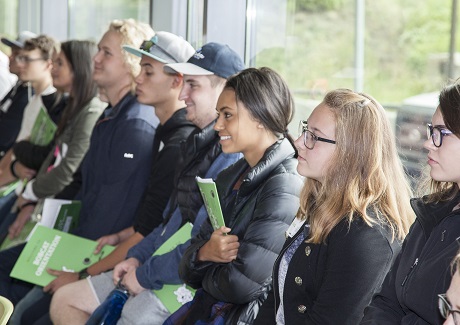First Year Experience
Newly standardized First Year Experience program aims to advance student success, increase retention
When it comes to planning an expedition, several factors help contribute to a successful
trip: detailed maps, the right gear and an overall level of preparedness. Navigating
the topography of higher education isn’t so different. An academic journey requires
mapping, planning and basic readiness to achieve the heights that one hopes for—with
an eye always fixed on the destination.
That’s the thinking behind Central Oregon Community College’s First Year Experience,
a student-support program that, starting this year, is offered to all new degree-
and certificate-seeking students. The First Year Experience, or FYE, centers on supporting
a meaningful and productive learning experience to help students target goals. And
to persevere.
Involving four phases, the program combines online, in-person and classroom tools and resources. The first, Bobcat Welcome, is a one-hour online orientation (done months ahead of fall term) that gives an overview of COCC through interactive videos, covering things like academic resources and financial aid. Students get answers to general questions and start to feel connected to their college.
“This is about creating success from the start,” explained Stephanie Bilbrey, COCC’s First Year Experience director, an all-new position. “We want our students to feel empowered.”
Then, during the spring or summer, they participate in Bobcat Advising, a two-hour
“mapping” session held at all four campuses. The first part of this is styled like
a lecture, where students learn key elements of academic programs and their placement.
The second half, taught in a computer lab, shows them how to use COCC’s new online
catalog, select—with an advisor—courses and use online course-planning tools, and
register for classes. “It’s a strong shift in our approach and more fully engages
the students in their academic planning,” said Alicia Moore, Vice President Student
Affairs.
It’s a time, Bilbrey noted, when students see COCC’s support structure up close. “When
you have faculty and staff that are team-oriented and mission-driven, students feel
that,” she said.
Part of the advising process involves math and writing placement testing—and it’s
a new era of placement tests at COCC, according to Beth Wright, placement coordinator.
“Instead of giving students a single test, we’re using multiple measures to place
students, by asking questions such as, ‘What year did they graduate, what was their
high school GPA, what was their last math or English course, and what was their grade
in that last math or English course.’” GPA in particular has been accurate in successful
placement.
A week prior to the start of fall term, students go to Bobcat Orientation, a four-hour
session that’s held at all four campuses and offers a college “warm-up” with workshops
and activities, designed to get them ready for their first three weeks of college,
a crucial window when dropouts can occur. College Success classes follow in the first
term, offered in hybrid-online and in-person formats, teaching things like study habits
and effective notetaking. Some are even embedded into actual program curriculum, such
as in wildland fire science and culinary.
Collectively, FYE is built upon the framework of a pre-existing, but less formalized,
effort. While the college has always supported its students and strived for steady
retention numbers, two influences helped mold a better-defined and packaged program:
the Oregon Promise and a Title III grant. The Oregon Promise requires its free-tuition
recipients to participate in a First Year Experience, while a $2.25 million federal
grant that COCC received in 2017 is aimed at raising student retention rates by five
percent over five years.
All phases are required of Oregon Promise students (in fact, they are the first ones
through FYE, serving as test pilots). For the rest, only Bobcat Welcome and Bobcat
Advising are the mandated parts, though the entire program is highly encouraged. “For
a lot of our students, coming here is the ‘exploration’ for a four-year university,”
said Bilbrey. “These tools help get them oriented.”
Early indicators show that FYE is yielding strong results. “When you look at their
success rates, they’re making it,” said Moore. Data reveals that in the fall of 2017,
88 percent of Oregon Promise students persisted. That represents a 12 percent bump
from just two years earlier, when FYE wasn’t yet rolled out.
Bilbrey points to another aspect of FYE that has enhanced COCC as a whole. “It’s so
moving to watch our ‘village’ collaborate,” she shared. “There’s an awe-inspiring
amount of people, across our campuses, who have focused their time on achieving this.”
By Mark Russell Johnson, COCC College Relations

